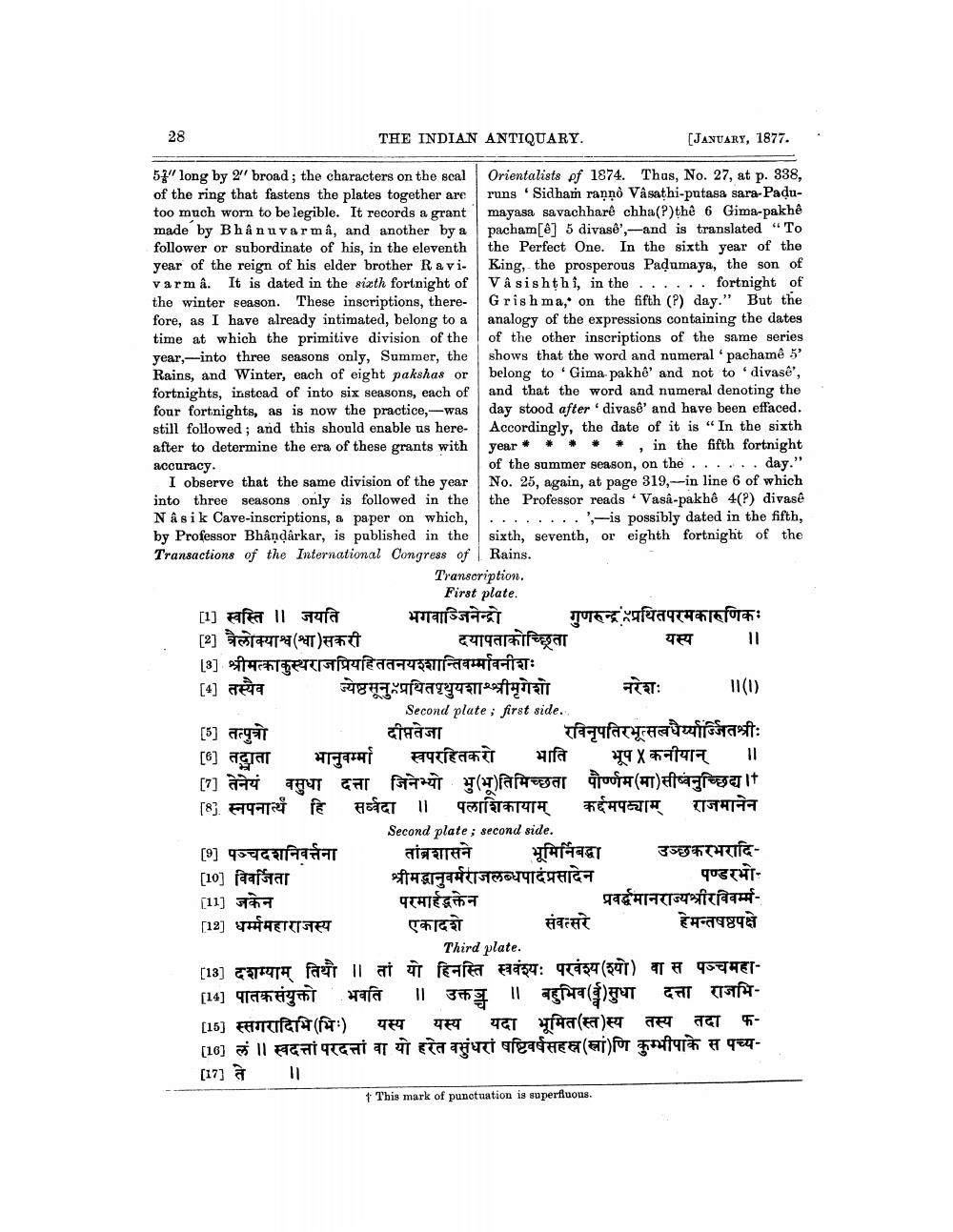________________
28
[ JANUARY, 1877.
Orientalists of 1874. Thus, No. 27, at p. 338, runs Sidham rannò Vâsathi-putasa sara-Padumayasa savachharé chha (P) the 6 Gima-pakhe pacham[ê] 5 divasê',-and is translated "To the Perfect One. In the sixth year of the King, the prosperous Padumaya, the son of Vasishthi, in the .. fortnight of Grishma, on the fifth (?) day." But the analogy of the expressions containing the dates of the other inscriptions of the same series shows that the word and numeral 'pachamê 5' belong to Gima pakhe' and not to 'divase', and that the word and numeral denoting the day stood after 'divase' and have been effaced. Accordingly, the date of it is "In the sixth in the fifth fortnight of the summer season, on the ......day." No. 25, again, at page 319,-in line 6 of which the Professor reads Vasa-pakhê 4(?) divasê ', is possibly dated in the fifth, sixth, seventh, or eighth fortnight of the Rains. Transcription. First plate.
year
[1] स्वस्ति || जयति
भगवाञ्जनेन्द्रो
दयापताकोच्छ्रिता
[2] त्रैलोक्याश्व (श्वा) सकरी [3] श्रीमत्काकुस्थराजप्रियहिततनयश्शान्तिवर्म्मावनीशः (4) तस्यैव
ज्येष्ठ सूनुः प्रथितपृथुयशा श्रीमृगेशो
Second plate; first side... दीप्ततेजा
THE INDIAN ANTIQUARY.
53" long by 2" broad; the characters on the scal of the ring that fastens the plates together are too much worn to be legible. It records a grant made by Bhânuvarmâ, and another by a follower or subordinate of his, in the eleventh year of the reign of his elder brother Ravivarmâ. It is dated in the sixth fortnight of the winter season. These inscriptions, therefore, as I have already intimated, belong to a time at which the primitive division of the year,—into three seasons only, Summer, the Rains, and Winter, each of eight pakshas or fortnights, instead of into six seasons, each of four fortnights, as is now the practice,-was still followed; and this should enable us hereafter to determine the era of these grants with accuracy.
I observe that the same division of the year into three seasons only is followed in the Nâsi k Cave-inscriptions, a paper on which, by Professor Bhandarkar, is published in the Transactions of the International Congress of
[5] तत्पुत्रो [6] ताता भानुवम्म [7] तेनेयं वसुधा दत्ता [8] स्नपनार्थं हि
[9] पञ्चदशनिवर्त्तना [10] विवर्जिता
[11] जकेन
(12) धर्म महाराजस्प
C
गुणरुन्द्र प्रथितपरमकारुणिकः
यस्य
जिनेभ्यो भु(भू) तिमिच्छता सर्व्वदा ॥ पलाशिकायाम्
नरेश:
रविनृपतिरभूत्सवधैतिश्रीः
स्वपरहितकरो भाति भूप X कनीयान्
||
↑ This mark of punctuation is superfluous.
11(1)
॥
पौर्णम (मा)सीष्वनुच्छिद्य।+ कर्दमपट्याम् राजमानेन
Second plate; second side. तनिशासने भूमिर्निबद्धा श्रीमद्भानुवर्मराजलब्धपादं प्रसादेन परमाद्भतेन
उच्छकरभरादिपण्डरभी
प्रवर्द्धमानराज्यश्रीरविव हेमन्तषष्ठपक्षे
एकादशे
संवत्सरे
Third plate.
[13] दशम्याम् तिथौ ॥ तां यो हिनस्ति स्ववंश्यः परवंश्य (इयो) वा स पञ्चमहा [14] पातकसंयुक्तो भवति ॥ उक्तञ्जु ॥ महुभिव (ई) सुधा दत्ता राजभि[16] [सगरादिभि (भिः) यस्य यदा भूमित (स्त) स्य तस्य तदा [10]] ] || वदतां परदतां वा यो हरेत वसुंधरां पष्टिवर्षसहस्र (सां) णि कुम्भीपाके स पथ्य[17] ते
यस्य
फ
||




